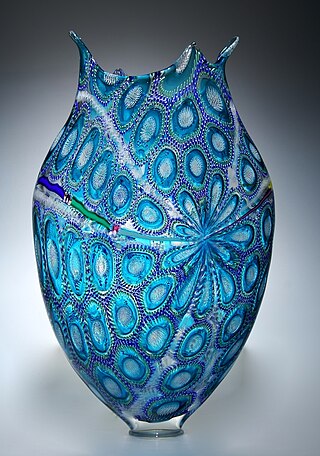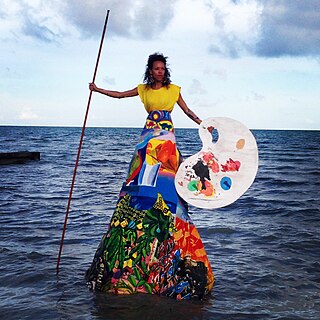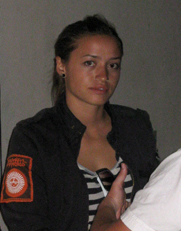
Milton Ernest "Robert" Rauschenberg was an American painter and graphic artist whose early works anticipated the Pop art movement. Rauschenberg is well known for his Combines (1954–1964), a group of artworks which incorporated everyday objects as art materials and which blurred the distinctions between painting and sculpture. Rauschenberg was both a painter and a sculptor, but he also worked with photography, printmaking, papermaking and performance.

Studio glass is the modern use of glass as an artistic medium to produce sculptures or three-dimensional artworks. The glass objects created are intended to make a sculptural or decorative statement. Though usage varies, the term is properly restricted to glass made as art in small workshops, typically with the personal involvement of the artist who designed the piece. This is in contrast to art glass, made by craftsmen in factories, and glass art, covering the whole range of glass with artistic interest made throughout history. Both art glass and studio glass originate in the 19th century, and the terms compare with studio pottery and art pottery, but in glass the term "studio glass" is mostly used for work made in the period beginning in the 1960s with a major revival in interest in artistic glassmaking.


Richard Dean Tuttle is an American postminimalist artist known for his small, casual, subtle, intimate works. His art makes use of scale and line. His works span a range of formats, from sculpture, painting, drawing, printmaking, and artist’s books to installation and furniture. He lives and works in New York City, Abiquiú, New Mexico, and Mount Desert, Maine.
Pilchuck Glass School is an international center for glass art education. The school was founded in 1971 by Dale Chihuly, Ruth Tamura, Anne Gould Hauberg (1917-2016), and John H Hauberg (1916-2002). The campus is located on a former tree farm in Stanwood, Washington in the United States. The administrative offices are located in Seattle. The name "Pilchuck" comes from the local Native American language and translates to "red water" in reference to the Pilchuck River. Pilchuck offers one, two, or three week resident classes each summer in a broad spectrum of glass techniques as well as residencies for emerging and established artists working in all media.
J. Morgan Puett is an American fashion designer and interdisciplinary contemporary artist. She first became known for her fashion designs and later for her contemporary art practice incorporating fashion.

The San Francisco Center for the Book (SFCB) is a non-profit organization founded in 1996 by Mary Austin and Kathleen Burch in San Francisco, California in the United States. The first center of its kind on the West Coast, SFCB was modeled after two similar organizations, The Center for Book Arts in New York City and the Minnesota Center for Book Arts in Minneapolis.

The Los Angeles Municipal Art Gallery is located in the Barnsdall Art Park in Los Angeles, California. It focuses on the arts and artists of Southern California. The gallery was first established in 1954.
Jean Shin is an American artist living in Brooklyn, NY. She is known for creating elaborate sculptures and site-specific installations using accumulated cast-off materials.

Sonya Clark is an American artist of Afro-Caribbean heritage. Clark is a fiber artist known for using a variety of materials including human hair and combs to address race, culture, class, and history. Her beaded headdress assemblages and braided wig series of the late 1990s, which received critical acclaim, evoked African traditions of personal adornment and moved these common forms into the realm of personal and political expression. Although African art and her Caribbean background are important influences, Clark also builds on practices of assemblage and accumulation used by artists such as Betye Saar and David Hammons.

Bryan Zanisnik is a contemporary artist working in video, performance, photography, and installation. Zanisnik's multidisciplinary practice uses objects en masse to explore American culture, Freudian psychology, and familial relationships. His site-specific installations have addressed diverse subjects, including a crumbling library of Philip Roth novels, an entropic swamp littered with Northern New Jersey waste, and an Americana museum reconstructed in Guangzhou, China. Critic David Duncan commented that Zanisnik "comical impartation of dubious history and catalogue of trivial possessions sidestep sentimentality while conveying a fascination with the type of inherited narrative that gets passed down in close-knit families."

The Utah Museum of Contemporary Art (UMOCA), formerly known as the Salt Lake Art Center, is a contemporary art museum located in downtown Salt Lake City. The museum presents rotating exhibitions by local, national, and international contemporary artists throughout its six gallery spaces.
Tomie Arai is an American artist and community activist. Her works consist of multimedia site-specific art pieces that deal with topics of gender, community, and racial identity. She is highly involved in community discourse, co-founding the Chinatown Art Brigade.

Marion Boulton Stroud, also known as Marion Stroud Swingle was an American curator, author, and museum director who was particularly active in her support of contemporary art, and of the use of textiles as a medium. She was the founder and director of The Fabric Workshop and Museum in Philadelphia, Pennsylvania, and a trustee and active supporter of the Philadelphia Museum of Art. She is commonly referred to as "Kippy".
Ginger Brooks Takahashi is an American artist based in Brooklyn, New York, and North Braddock, Pennsylvania. A self-identified “punk,” Takahashi grew up in Oregon. She co-founded the feminist genderqueer collective and journal LTTR and the Mobilivre project, a touring exhibition and library. She was also a member of MEN (band). Her work consists of a collaborative project-based practice. Takahashi is currently an adjunct professor of Art at Carnegie Mellon University.

Paula Wilson is an African-American "mixed media" artist creating works examining women's identities through a lens of cultural history. She uses sculpture, collage, painting, installation, and printmaking methods such as silkscreen, lithography, and woodblock. In 2007 Wilson moved from Brooklyn, New York, to Carrizozo, New Mexico, where she currently lives and works with her woodworking partner Mike Lagg.

Rose B. Simpson is a mixed-media artist who works in ceramic, metal, fashion, painting, music, performance, and installation. She lives and works in Santa Clara Pueblo, New Mexico. Her work has been exhibited at SITE Santa Fe ; the Heard Museum ; the Museum of Contemporary Native Art, Santa Fe (2010); the National Museum of the American Indian, Smithsonian (2008); the Denver Art Museum; Pomona College Museum of Art (2016); Ford Foundation Gallery (2019); The Wheelwright Museum of the American Indian (2017); the Minneapolis Institute of Art (2019); the Savannah College of Art and Design (2020); and the Nevada Museum of Art (2021).
The Print Center is a nonprofit gallery located in Rittenhouse Square in Philadelphia. Originally known as The Print Club, the gallery's mission is to "encourage the growth and understanding of photography and printmaking as vital contemporary arts through exhibitions, publications and educational programs".
Virgil Marti is an American visual artist recognized for his installations blending fine art, design, and decor from a range of styles and periods. Marti’s immersive sculptural environments, often evoking nature and the landscape, combine references from high culture with decorative, flamboyant, or psychedelic imagery, materials, and objects of personal significance.
Leroy Johnson was a largely self-taught African American artist who used found materials to create mixed-media works. He was known for his paintings, assemblage sculptures and collages that were inspired, influenced and reflective of African American history and his experiences living in the inner city of Philadelphia.












